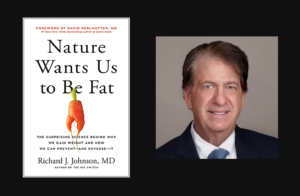 The two popular theories that purport to explain the obesity pandemic are the carbohydrate insulin model and the standard model of energy balance. In Why Nature Wants Us to be Fat, nephrologist Richard Johnson bravely proposes another theory: the survival switch.
The two popular theories that purport to explain the obesity pandemic are the carbohydrate insulin model and the standard model of energy balance. In Why Nature Wants Us to be Fat, nephrologist Richard Johnson bravely proposes another theory: the survival switch.
In his formulation, nature has evolved a survival mechanism allowing organisms to rapidly gain weight in response to stress or in preparation for periods of scarcity. It is meant to be turned on occasionally in response to adversity, but our food environment has interacted with our evolutionary biology to turn the switch on continuously, leading to widespread obesity. The survival switch is mediated by the molecule fructose, and Johnson pins much of the blame on pervasive consumption of high fructose containing foods and beverages which were introduced in the 1970’s. Fructose metabolism triggers an intracellular starvation type response in the liver that ultimately leads to leptin resistance and diminished satiety, which then causes persistently disordered appetite. Fructose causes obesity not because of its caloric or nutritive value, but rather by hijacking appetite. Sucrose too is implicated, as it is broken down to equal parts fructose and glucose.
The book impressively draws from biochemistry and clinical science as well as comparative biology, evolutionary science, bio-anthropology and paleontology to synthesize a coherent theory to explain our current global metabolic perdicament. According to Johnson, a classic example of the survival switch is mammalian hibernation. To take that example, in preparation for winter the bear markedly ramps up its consumption of fructose-containing blueberries in order to build fat stores, which become a source of both calories and water during its hibernation. Similarly, birds often switch from insect diets to fruit and nectar-filled diets as winter approaches in order to gain fat. In this way animal and fruit-bearing plant life are in seasonal harmony.
The fundamental issue is that fructose metabolism simulates an intracellular energy deficit in a dose dependent fashion by rapidly diminishing intracellular ATP by 20-60%. As a result, appetite and fat deposition are stimulated. Fructose is known to cause central leptin resistance by hypothalamic inflammation, which would naturally increase appetite. Additionally, in the presence of fructose, saturated fats are particularly obesogenic. Finally, mitochondria suffer oxidative stress because of fructose.
In the absence of fructose, other stimuli such as high salt, dehydration and umami (glutamate) can also trigger the survival switch by pushing conversion of glucose to sorbitol and then to fructose through the polyol pathway. High glycemic carbs will increase fructose production as well, and this is probably the number one way in which people are exposed to fructose today outside of supplemented HFCS.

According to Johnson, animals are drawn to salt-licks because the salt triggers the conversion of glucose to fructose, which in turn helps them put on weight. To the extent that ultra-processed foods are formulated with high concentrations of salt and sugar, they are continually triggering this metabolic switch on a global scale.
Johnson suggests inhibitors of fructose metabolism would prevent the adverse consequences of the western diet and would by themselves prevent NAFLD. There happens to be a number of Pharma groups working on fructokinase inhibitors. Luteolin is a naturally occurring flavone that blocks fructose metabolism and has been associated with renal protection.
This is a fascinating book by a researcher who has stature and standing in the field, but his identification of the survival switch as the cause of the majority of maladies afflicting mankind gives pause. Yet the theory is cohesive, supported by empirical evidence and powerfully explains much of our current predicament. I am swayed.
